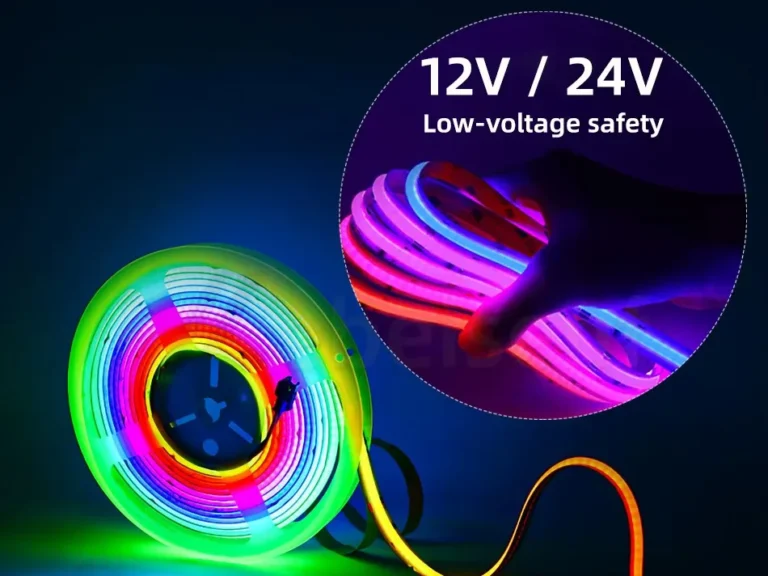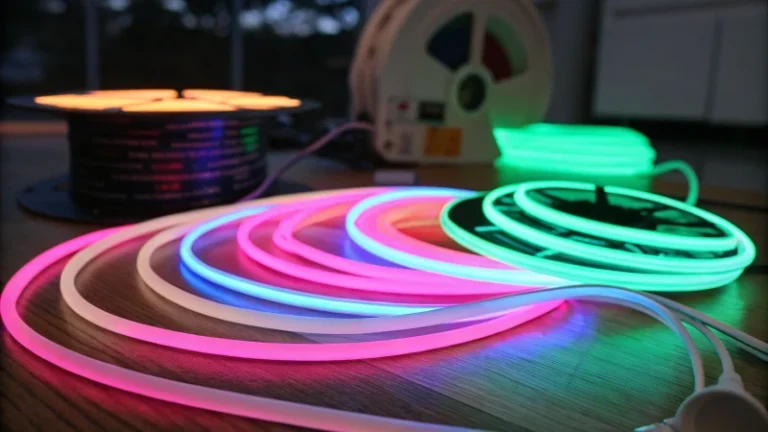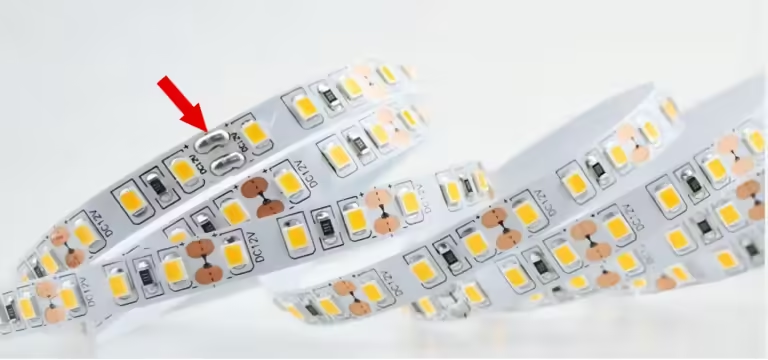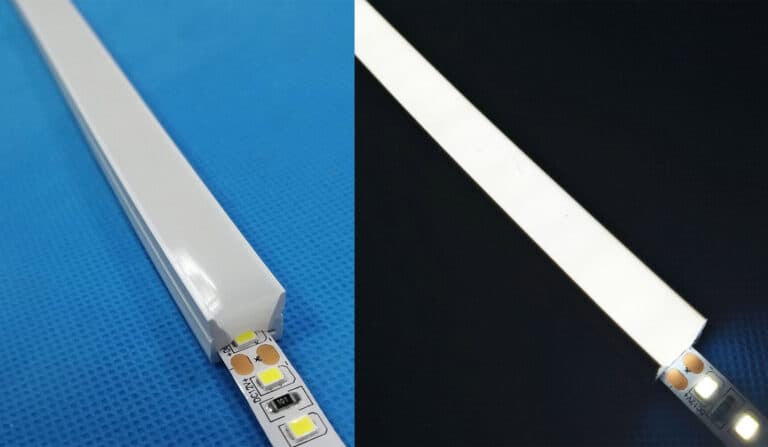When it comes to dynamic RGB lighting, most people think of low-voltage DC addressable strips. But in recent years, a quiet shift has been taking place—more contractors and lighting professionals are choosing AC addressable LED strip lights for large-scale outdoor and architectural projects. Why? Because AC RGB strips can run up to 50 meters without voltage drop, require no bulky power supply, and offer plug-and-play convenience. While DC strips offer fine control and flexibility, AC versions win in simplicity, distance, and cost-efficiency—especially in 110V or 220V regions. In this article, we’ll explore the key differences between AC and DC addressable LED strips, and help you decide which is the right choice for your next project.

What Are AC Addressable LED Strip Lights?
AC addressable LED strip lights are high-voltage RGB strips that can display dynamic lighting effects without the need for a low-voltage power supply. Designed to work directly with 110V or 220V AC input, these strips convert alternating current to direct current internally using a built-in rectifier circuit, allowing for consistent and safe operation.
Unlike standard DC addressable strips that require an external controller and power adapter, AC RGB strips often come in plug-and-play kits, making them ideal for long-distance installations—up to 50 meters in a single run—without brightness drop.
These strips are usually semi-addressable, meaning each segment (often 1 meter or half a meter) can display different colors or chase effects, depending on the built-in IC type.
Common IC options include:
SM16703/SM16716: Supports segment-level dynamic effects.
TM1934 or similar: Often used in waterproof outdoor applications.
Internal MCU-based ICs: Custom ICs built into AC driver modules for specific effects.
Key Features:
Works with 110V or 220V directly
Long single-run capability (up to 50m)
IP65–IP68 waterproof options
Easy installation, ideal for outdoor or commercial lighting
They can work without controller with bulit-in programs
What Are DC Addressable LED Strip Lights?
DC addressable LED strip lights are low-voltage RGB strips that allow for pixel-level lighting control using external controllers. They typically operate at 5V, 12V, or 24V DC, and are widely used in decorative, signage, and animation lighting projects.
There are two main control types:
SPI (Serial Peripheral Interface):
Ideal for complex lighting effects and pixel control. Each LED (or group) has its own address.
Common ICs: WS2812B, WS2811, SK6812, UCS1903, APA102.
DMX (Digital Multiplex):
Used in professional lighting systems such as stage, event, and building facade lighting.
Common ICs: TM512, TM1934, SM17512, UCS512C.
DC addressable strips offer flexibility, smooth effects, and precision, but require a controller and power supply. They’re best for short to medium-length runs due to voltage drop limitations.
If you want to learn more about DC addressable LED strip lights, check out our in-depth guide here: Pixel Addressable LED Strip Comparison: DMX512 vs. SPI

AC vs DC Addressable LED Strip: What’s the Difference?
Choosing between AC and DC addressable LED strip lights depends on the needs of your project—whether it’s about installation simplicity, control precision, safety, or long-distance performance.
AC addressable strips are designed for direct connection to 110V or 220V, making them ideal for outdoor or large-scale projects where long runs and quick installation matter most. These strips usually offer segment-level effects (e.g., every 50cm or 1m) and come with a plug-and-play controller. No external power supply is needed, and they can reach up to 50 meters in a single run without noticeable brightness drop.
On the other hand, DC addressable strips operate on safe low-voltage power (5V/12V/24V) and offer pixel-level control. They support rich animation effects and are widely used in signage, interior design, gaming setups, and interactive installations. However, they require external power supplies, voltage drop becomes an issue after a few meters, and installation is more complex.
In short, AC = simplicity and distance, while DC = control and precision.
| Feature | AC Addressable Strip | DC Addressable Strip |
| Working Voltage | 110V / 220V AC | 5V / 12V / 24V DC |
| Control Type | Segment-level (basic effects) | Pixel-level (precise control via SPI/DMX) |
| Max Run Length | Up to 50 meters | 5–10 meters (requires power injection) |
| Power Supply Required | No (built-in rectifier) | Yes (external driver & controller) |
| Installation | Plug-and-play | Requires wiring and setup |
| Safety | Higher voltage risk (needs protection) | Low voltage, safer for handling |
| Flexibility | Rigid or semi-flexible | Highly flexible |
| Typical Applications | Outdoor facades, commercial lighting | Signs, animations, interior decoration |
| Cost Efficiency | Lower total cost for long runs | Higher cost due to accessories |
Pros and Cons of AC RGB Addressable LED Strip Lights
Like any lighting solution, AC addressable RGB LED strips come with both advantages and limitations. Understanding these can help you choose the right product for your application—especially in large-scale or outdoor lighting projects.
Advantages:
Long Continuous Runs (Up to 50M)
No need for power injection or signal repeaters. Ideal for building facades, corridors, or perimeter outlines.
Plug-and-Play Installation
No need for external DC power supplies or complex wiring. Save on installation labor and time.
Lower System Cost
Fewer accessories (power supplies, amplifiers, etc.) make AC strips more budget-friendly for large projects.
High Waterproof Options
Many models come with IP65–IP68 protection, perfect for outdoor use in rain, dust, or snow.
Built-in Control Options
Most strips include a basic controller with dynamic effects like color chasing, breathing, and flashing—ready to use right out of the box.
Disadvantages:
Limited Pixel Control
AC strips typically support only segment-based effects, not per-LED animations. Not suitable for fine-resolution designs or interactive lighting.
Higher Voltage = Higher Safety Risk
Direct connection to 110V or 220V requires careful handling and proper waterproof sealing to avoid electrical hazards.
Less Flexible in Shape
AC strips are often stiffer than DC counterparts due to internal circuit design, making them harder to bend or shape tightly.
Not Ideal for Close-Range Installations
Because of safety and heat considerations, AC RGB strips are better suited for out-of-reach or outdoor installations.
Where Are AC Addressable LED Strips Used?
Thanks to their long run length, waterproof protection, and plug-and-play design, AC addressable LED strips are widely used in large-scale and outdoor projects where quick installation and wide coverage are key. Here are some common applications:
1. Building Facade Lighting
AC RGB strips are perfect for outlining high-rise buildings, commercial plazas, and architectural landmarks. With up to 50 meters per reel, they reduce wiring complexity while delivering dynamic color effects across long distances. IP67-rated versions can withstand rain and wind year-round.

2. Bridge and Tunnel Decoration
In infrastructure projects such as bridges, tunnels, and overpasses, AC addressable strips provide vibrant linear effects with minimal maintenance. Their high voltage input makes them compatible with city power systems, and waterproofing ensures safe use in exposed environments.

3. Shopping Mall or Commercial Perimeter Lighting
Used along rooflines, entrances, or window edges, these strips can create attention-grabbing light animations that enhance a building’s nighttime appearance. The built-in controllers simplify wiring, saving time for contractors working under tight deadlines.
4. Outdoor Festival or Holiday Installations
For temporary installations like Christmas, New Year, or city events, AC strips allow fast setup with minimal accessories. Their plug-in design eliminates the need for external drivers, making them ideal for seasonal lighting contractors.
Choosing Between AC and DC RGB LED Strip: Which One Do You Need?
When deciding between AC and DC addressable RGB LED strips, the right choice depends on your project goals, installation environment, and budget. Each type has its strengths—it’s not about which one is better, but which one fits your needs.
Choose AC RGB LED Strip if:
You need to install long runs (up to 50 meters) without voltage drop or power injection.
The project is outdoor or commercial, such as facade lighting, signage borders, or landscape features.
You want a faster installation with fewer components—just plug and play.
You’re working with 110V or 220V power sources directly and want to minimize accessories.
You prefer cost-effective large-scale lighting with segment-level control.
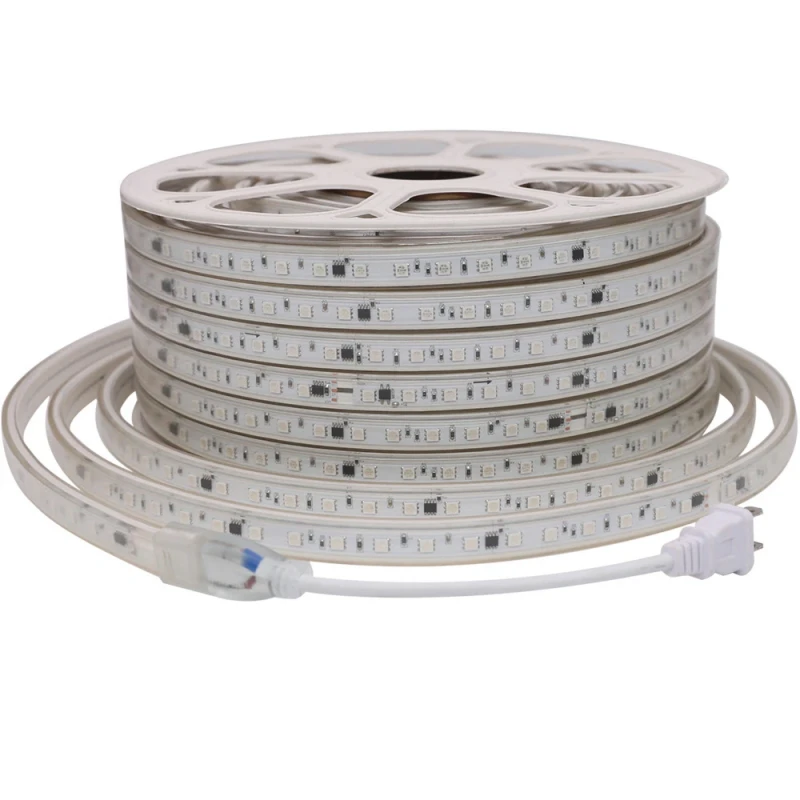
AC 110V/220V addressable LED Strip Light
Model No.: EAA10T060G
Input Voltage: AC110V/220V
Watt: 10W/m
LED QTY: SMD5050 60LEDs/m
Color Temperature: addressable RGB
IP Grade: IP68
Cuttable Length: 1000mm
Length: 50meters/roll
Warranty: 2years
Price: 3USD
Choose DC RGB LED Strip if:
You need precise pixel control, such as individual LED animations or advanced effects.
Your application is indoor or decorative, like signage, display cases, or gaming rooms.
You require flexible installation in curves, corners, or custom shapes.
You have experience or support for controllers, power supplies, and programming.
The lighting is part of an interactive or creative system, such as DMX-based shows or SPI effects.
If you want to buy DC addressable RGB LED strip light, click here to check more products: DC addressable strip light
In short:
AC = Simpler, Longer, Outdoor
DC = Smarter, Flexible, Detailed Control
Still unsure? A hybrid approach is also possible—some projects use AC strips for perimeter lighting, and DC strips for focal animation zones.
How to Safely Use 110V/220V AC LED Strip Lights
While AC RGB LED strips offer convenience and long-distance performance, they operate at high voltage (110V or 220V), which demands greater attention to safety during installation and use. Below are key guidelines to ensure safe and reliable operation in commercial and outdoor environments:
1. Use Waterproof Connectors and End Caps
Always seal both ends of the strip with IP65+ waterproof connectors and end caps filled with silicone. This prevents water ingress and short circuits, especially in outdoor or semi-open installations.
2. Mount Strips Out of Reach
Due to the high voltage, avoid placing strips where people may directly touch them. Install them along high walls, ceilings, eaves, or behind diffusers to reduce risk.
3. Choose Certified Products
Only use strips with CE, ETL, or UL certification to ensure compliance with safety standards. Reliable internal drivers and flame-retardant materials are essential for stable performance.
4. Use Leakage Protection (RCD/RCBO)
Always install residual current devices (RCD) or RCBOs in the power circuit. These safety switches cut off power immediately in case of leakage or short circuit, protecting both people and property.
5. Avoid Coiling During Operation
Never operate AC LED strips while coiled or tightly looped, as this can cause overheating. Always install them fully unrolled on a heat-dissipating surface like aluminum or PVC channels.
6. Label and Secure All Power Points
Mark all AC connection points clearly, and use heat-shrink sleeves or insulated boxes to protect exposed terminals. Keep control boxes and power interfaces protected from moisture and vandalism.
Taking these precautions ensures that your AC RGB strip installation is not only brilliant—but also safe, durable, and compliant with international standards.

AC Addressable RGB LED Strip Light Factory
Looking for a one-stop supplier for both AC and DC addressable RGB LED strips?
Signlite offers a complete range of high-quality RGB lighting solutions for commercial, architectural, and decorative projects.
We manufacture both 110V/220V AC RGB strips and 5V/12V/24V DC pixel strips, supporting everything from long-distance building outlines to detailed animation lighting. Whether you need plug-and-play convenience or pixel-level control, we’ve got you covered.
We also support customization—length, waterproof level, color effects, and control methods can all be tailored to fit your project needs.
